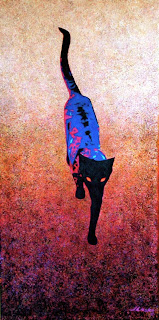 "The Cat"
"The Cat"It seems many work-at-home creative people have cats. Cats seem to be the perfect companion for a painter or writer with just the right energy and few demands. I have been blessed with the perfect feline companion who seems to enjoy my studio time as much as I do. I like to get my chores and obligations done before I paint, and she will often go to the studio and wait for me.
My cat, dear Sophie, likes to be where I like to be. I mean exactly. If I am standing while painting, I must remember not to step on her because she likes to sleep at my feet. Painting with a cat on ones lap is lovely in some ways, but it is not good for serious work. It is usually her choice to be on my lap, but, too much movement by me and she will remove herself indignantly. If I get up from my chair, she claims it immediately. I wonder sometimes if like dogs who clearly love to sit in the drivers seat when it becomes available, if cats don't feel that our chair is the seat of power and therefore rightfully theirs.
Sophie has some peculiarities, she was hired on originally as a mouser. She is an excellent hunter, and she did rid us of all of the household pests. As if she feels obliged to prove her worth, she now persists in bringing them in to the house and letting them go until she can catch them again at her leisure. Sophie is very quiet, hardly ever a meow. She only eats expensive cat food, graciously leaving human food alone. She never walks on the kitchen counter or table if we are at home. On all my canvases, one could probably find at least one cat hair unintentionally worked into the paint or varnish.
My son Adam, who also makes his living as an artist, had a sign in his studio which read "Dogs have masters, cats have staff". His cats spent many long hours keeping him company while he worked. MeMe, an intense personality in a small fur package, was an inspiration for many drawings featuring her Jekel/Hyde personality.
There is a facebook page, Artists and Cats created by Todd Pendu with 603 members http://www.facebook.com/group.php?gid=61949694304 , and a website too. http://www.pendu.org/exhibitions/artistsandcats/2008.htm
"Working with a group of artists is like herding cats" is an expression that I heard first this year when our arts organization was doing a fundraiser with thirty artists. I volunteered to be the link between the association and the artists. For the most part, it was a wonderful experience. Each artist as an individual was charming, cooperative, and delivered on time. As a collective, they were difficult to get all in the same place at the time. I have forgotten who said it first, but once we heard the phrase, it became the final word on dealing with a group of artists …. "Its like herding cats". If any of you are in that position of trying to organize a group of creative people, I recommend website essay written by Anne Miller, Director of The Creativity Partnership. http://www.tcp-uk.co.uk/docs/4022%20cat%20herder.pdf and David Parrish's Leading Creative People http://blog.davidparrish.com/tshirts_and_suits/2007/06/leading-creativ.html
Sophie has been the inspiration for several paintings. She is almost completely black. In the painting above, it is her sleek silhouette that inspired the painting above. Another painting is almost totally black with only her glowing eyes and blue highlight on her luxurious coat illuminated. Both paintings were for my own pleasure and not intended to sell, but they did. No complaints, because replacing them will be a labor of love.
Below is a few quotes about cats from a list of some of the world's most creative people. For more interesting facts and quotes about cats: http://www.greatdreams.com/cats/cats2.htm
Leonardo Da Vinci "The smallest feline is a masterpiece".
Adolf Hitler is known to have despised cats.
Garrison Keillor "Cats are intended to teach us that not everything in nature has a function".
Edgar Allen Poe "I wish I could write as mysterious as a cat".
Sir Isaac Newton, (theory of gravity) also invented the swinging cat door for the convenience of his many cats.
Albert Schweitzer "There are two means of refuge from the miseries of life: music and cats".
Aldous Huxley "If you want to be a psychological novelist and write about human beings, the best thing you can do is keep a pair of cats".


































